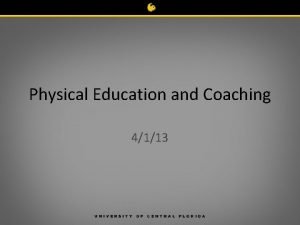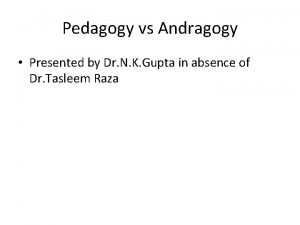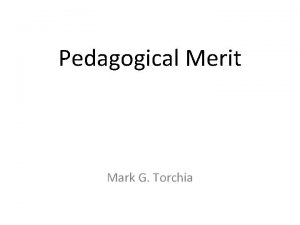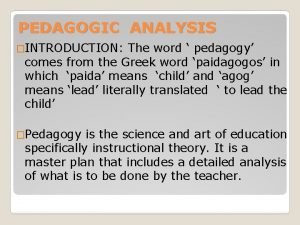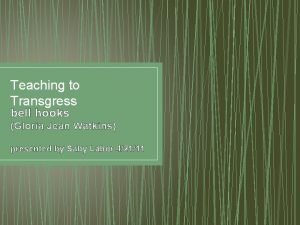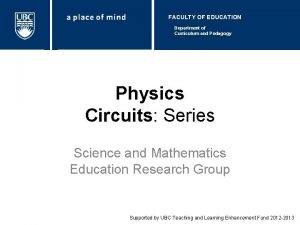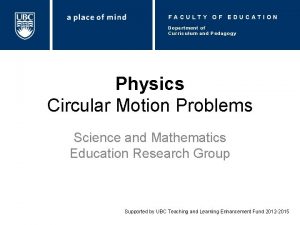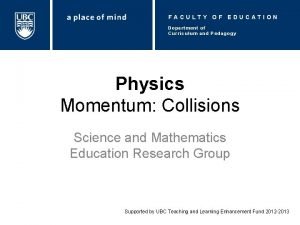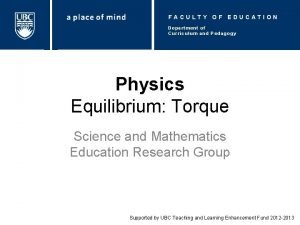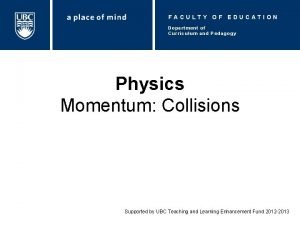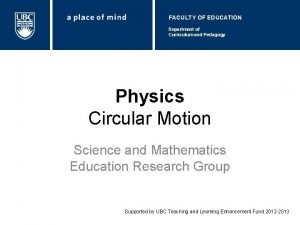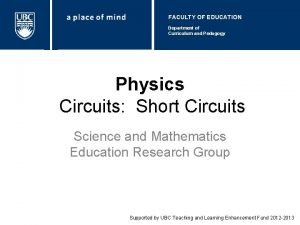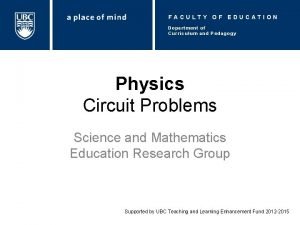FACULTY OF EDUCATION Department of Curriculum and Pedagogy




























- Slides: 28

FACULTY OF EDUCATION Department of Curriculum and Pedagogy Physics Electromagnetism: Induced Currents Science and Mathematics Education Research Group Supported by UBC Teaching and Learning Enhancement Fund 2012 -2013

Induced Currents in a Loop of Wire I B

Induced Currents I Consider a loop of wire with radius r and resistance R placed in an external magnetic field. Which of the following can induce a current in the loop of wire? I. A constant magnetic field II. A magnetic field changing in magnitude III. A magnetic field changing in direction A. I and II only r B. I and III only C. II and III only D. I, II, and III E. None of the above

Solution Answer: C Justification: According to Faraday’s law, the magnitude of induced emf on the loop is: The induced emf only depends on the rate of change of the magnetic flux FB through the loop. A changing magnetic flux can either mean a magnetic field that is changing in magnitude, or in direction or if the area of the loop is changing in size (stretching or squeezing the loop).

Induced Currents II A loop of wire with radius R is in a magnetic field that is increasing in magnitude at 1 T/s. What is the direction of the current induced in the loop? A. Clockwise B. Counter-clockwise C. No induced current

Solution Answer: B Justification: The magnetic field is increasing in magnitude and is directed into the page. According to Faraday`s law, the loop of wire will induce a magnetic field to oppose this change. Thus the induced magnetic field must be directed out of the page. The induced current must therefore be counter-clockwise. I B

Induced Currents III A loop of wire with radius R is in a magnetic field that is decreasing in magnitude at 1 T/s. What is the direction of the current induced in the loop? A. Clockwise B. Counter-clockwise C. No induced current

Solution Answer: A Justification: The magnetic field is decreasing in magnitude and is directed into the page. According to Faraday`s law, in order to oppose this change, the loop of wire will induce a magnetic field also directed into the page. The induced current must therefore be directed clockwise. I B

Induced Currents IV A loop of wire with radius R is in a magnetic field that is increasing in magnitude at 1 T/s. What is the direction of the current induced in the loop? A. Clockwise B. Counter-clockwise C. No induced current

Solution Answer: A Justification: The magnetic field is increasing in magnitude and is directed out of the page. To oppose this change, the loop of wire will induce a magnetic field directed into the page. The induced current must therefore be directed clockwise. I B

Induced Currents V A loop of wire with radius R is in a magnetic field that is decreasing in magnitude at 1 T/s. What is the direction of the current induced in the loop? A. Clockwise B. Counter-clockwise C. No induced current

Solution Answer: B Justification: The magnetic field is decreasing in magnitude and is directed out of the page. To oppose this change, the loop of wire will induce a magnetic field directed out of the page. The induced current must therefore be counterclockwise. I B

Induced Currents VI A loop of wire with radius R is in a magnetic field that is increasing in magnitude at 1 T/s. What is the direction of the current induced in the loop? A. Clockwise B. Counter-clockwise C. No induced current

Solution Answer: C Justification: No magnetic field lines pass through the loop, so there is no magnetic flux through it. There is no induced emf. B θ Bnormal to area In this case θ = 90° so there is no flux through the loop. Even though B is increasing, the flux will remain 0 Wb.

Induced Currents VII A loop of wire in is placed in a constant magnetic field. The loop rotates along an axis at a constant angular velocity ω as shown. Consider the time just before the loop is parallel to the magnetic field (a moment before the point shown in the diagram). Which of the following correctly describes the magnitude of the flux and the direction of current through the loop? Axis of rotation A. Flux: increasing / Current: CW B. Flux: increasing / Current: CCW C. Flux: decreasing / Current: CW D. Flux: decreasing / Current: CCW E. Flux: constant / No induced current CW = clockwise B field constant CCW = counter-clockwise (According to an observer looking into the page)

Solution Answer: D Justification: A moment before the loop becomes parallel with the magnetic field, a decreasing number of magnetic field lines were able to pass the through loop. Therefore, the magnitude of the flux was decreasing to zero. View of Observer B induced to increase flux A counter-clockwise current (from the point of view of the observer) will increase the magnetic flux through the loop in order to oppose the decrease.

Induced Currents VIII Consider the time just after the loop is parallel to the magnetic field (a moment after the point shown in the diagram). Which of the following correctly describes the magnitude of the flux and the direction of current through the loop? A. Flux: increasing / Current: CW Axis of rotation B. Flux: increasing / Current: CCW C. Flux: decreasing / Current: CW D. Flux: decreasing / Current: CCW E. Flux: constant / No induced current CW = clockwise CCW = counter-clockwise B field constant (According to an observer looking into the page)

Solution Answer: B Justification: A moment after the loop is parallel with the magnetic field, an increasing number of magnetic field lines will be able to pass through the loop. Therefore, the magnitude of the flux will be increasing from zero. View of Observer B induced to decrease flux A counter-clockwise current (from the point of view of the observer) will decrease the magnetic flux through the loop in order to oppose the increase.

Induced Currents IX Consider the time when the loop is parallel to the magnetic field. The magnetic flux through the loop at this time is zero. What is the direction of the induced current (according to an observer looking into the page)? Axis of rotation A. Clockwise B. Counter-clockwise C. No induced current B field constant

Solution Answer: B Justification: Even though the flux through the loop is zero, there is still an induced current because the flux is changing. The rate of change of the magnetic flux is at a maximum when the loop is parallel to the external magnetic field. Moment before: View of Observer B induced to increase flux View of Observer Moment after: B induced to decrease flux Notice that the direction of current remains counter-clockwise.

Solution (Optional) Even though the magnitude of the flux changes from decreasing to increasing, the rate of change of flux can be at a maximum if negative magnetic flux are taken into consideration (so that the flux actually decreases to negative values), rather than increase once the flux becomes zero). Flux can be negative since it is defined as the dot (scalar) product of the magnetic field and area vector θ = 90°. θ = 180° θ = 270° When θ = 90° or θ = 270°, the flux is zero because cos θ = 0. The induced emf is therefore at its maximum magnitude because sin θ = 1 or sin θ = -1.

Induced Currents X Consider the time just before the loop is perpendicular to the magnetic field (a moment before the point shown in the diagram). Which of the following correctly describes the magnitude of the flux and the direction of current through the loop? A. Flux: increasing / Current: CW Axis of rotation B. Flux: increasing / Current: CCW C. Flux: decreasing / Current: CW D. Flux: decreasing / Current: CCW E. Flux: constant / No induced current CW = clockwise B field constant CCW = counter-clockwise (According to an observer looking into the page)

Solution Answer: A Justification: A moment before the loop becomes perpendicular to the magnetic field, an increasing number of magnetic field lines were able to pass the through loop. Therefore, the magnitude of the flux was increasing. View of Observer B induced to decrease flux A clockwise current (from the point of view of the observer) will decrease the magnetic flux through the loop in order to oppose the increase.

Induced Currents XI Consider the time just after the loop is perpendicular with the magnetic field (a moment after the point shown in the diagram). Which of the following correctly describes the magnitude of the flux and the direction of current through the loop? A. Flux: increasing / Current: CW Axis of rotation B. Flux: increasing / Current: CCW C. Flux: decreasing / Current: CW D. Flux: decreasing / Current: CCW E. Flux: constant / No induced current CW = clockwise CCW = counter-clockwise B field constant (According to an observer looking into the page)

Solution Answer: D Justification: A moment after the loop becomes perpendicular to the magnetic field, a decreasing number of magnetic field lines will be able to pass the through loop. Therefore, the magnitude of the flux will be decreasing. View of Observer B induced to increase flux A counter-clockwise current (from the point of view of the observer) will increase the magnetic flux through the loop in order to oppose the decrease.

Induced Currents XII Consider the time when the loop is perpendicular with the magnetic field. The magnetic flux through the loop at this time is at its maximum. What is the direction of the induced current (according to an observer looking into the page)? Axis of rotation A. Clockwise B. Counter-clockwise C. No induced current B field constant

Solution Answer: C Justification: A moment before the loop was perpendicular the current was clockwise. A moment after the loop is perpendicular the current will be counter-clockwise. At the time the loop is perpendicular with the magnetic field the current must be transitioning from a clockwise direction to a counter-clockwise direction. There is momentarily no induced current through the loop. View of Observer Moment before: Moment after:

Solution (Optional) Whenever θ = 0° or θ = 180° , the magnetic flux is at a maximum (positive) value or a minimum (negative) value. The rate of change of magnetic flux is zero at these values of θ. θ = 90° θ = 180° θ = 270°
 Education scotland play pedagogy toolkit
Education scotland play pedagogy toolkit Gauteng department of education strategic plan 2020
Gauteng department of education strategic plan 2020 Nit calicut chemistry department
Nit calicut chemistry department Tapp program georgia
Tapp program georgia Definition of sport pedagogy
Definition of sport pedagogy Advanced pedagogy and application of ict book pdf
Advanced pedagogy and application of ict book pdf Epistemology and pedagogy
Epistemology and pedagogy Importance of faculty in higher education
Importance of faculty in higher education York university concurrent education acceptance rate
York university concurrent education acceptance rate Feri maribor
Feri maribor Uvu professor salary
Uvu professor salary Faculty of education khon kaen university
Faculty of education khon kaen university Techno-pedagogy
Techno-pedagogy Public pedagogy definition
Public pedagogy definition Pedagogy vs androgogy
Pedagogy vs androgogy Pedagogists means
Pedagogists means Example of equity pedagogy
Example of equity pedagogy What is gender responsive pedagogy
What is gender responsive pedagogy Maria__090915
Maria__090915 Pedagogy pronounce
Pedagogy pronounce Advantages and disadvantages of pedagogical analysis
Advantages and disadvantages of pedagogical analysis Gradual release of responsibility pedagogy
Gradual release of responsibility pedagogy Conclusion of ict in education
Conclusion of ict in education Divine pedagogy
Divine pedagogy A pedagogy of multiliteracies: designing social futures
A pedagogy of multiliteracies: designing social futures Humanising pedagogy
Humanising pedagogy Top-down approach in reading
Top-down approach in reading Bell hooks engaged pedagogy summary
Bell hooks engaged pedagogy summary Pedagogy of the oppressed chapter 1
Pedagogy of the oppressed chapter 1




